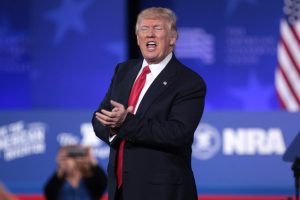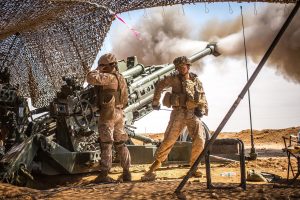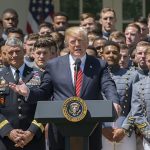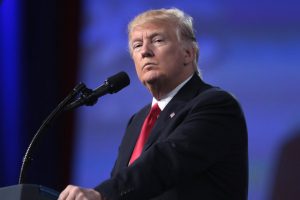by William Hartung
Until recently, few of us woke up worrying about the threat of nuclear war. Such dangers seemed like Cold War relics, associated with outmoded practices like building fallout shelters and “duck and cover” drills.
But give Donald Trump credit. When it comes to nukes, he’s gotten our attention. He’s prompted renewed concern, if not outright alarm, about the possibility that such weaponry could actually be used for the first time since the 6th and 9th of August 1945. That’s what happens when the man in the Oval Office begins threatening to rain “fire and fury like the world has never seen” on another country or, as he did in his presidential campaign, claimingcryptically that, when it comes to nuclear weapons, “the devastation is very important to me.”
Trump’s pronouncements are at least as unnerving as President Ronald Reagan’s infamous “joke” that “we begin bombing [the Soviet Union] in five minutes” or the comment of a Reagan aide that, “with enough shovels,” the United States could survive a superpower nuclear exchange.
Whether in the 1980s or today, a tough-guy attitude on nuclear weapons, when combined with an apparent ignorance about their world-ending potential, adds up to a toxic brew. An unprecedented global anti-nuclear movement — spearheaded by the European Nuclear Disarmament campaign and, in the United States, the Nuclear Freeze campaign — helped turn President Reagan around, so much so that he later agreed to substantial nuclear cuts and acknowledged that “a nuclear war cannot be won and must never be fought.”
It remains to be seen whether anything could similarly influence Donald Trump. One thing is certain, however: the president has plenty of nuclear weapons to back up his aggressive rhetoric — more than 4,000 of them in the active U.S. stockpile, when a mere handful of them could obliterate North Korea at the cost of millions of lives. Indeed, a few hundred nuclear warheads could do the same for even the largest of nations and those 4,000, if ever used, could essentially destroy the planet.
In other words, in every sense of the term, the U.S. nuclear arsenal already represents overkill on an almost unimaginable scale. Independent experts from U.S. war colleges suggest that about 300 warheads would be more than enough to deter any country from launching a nuclear attack on the United States.
Despite this, Donald Trump is all in (and more) on the Pentagon’s plan — developed under Barack Obama — to build a new generation of nuclear-armed bombers, submarines, and missiles, as well as new generations of warheads to go with them. The cost of this “modernization” program? The Congressional Budget Office recently pegged it at $1.7 trillion over the next three decades, adjusted for inflation. As Derek Johnson, director of the antinuclear organization Global Zero, has noted, “That’s money we don’t have for an arsenal we don’t need.”
Building a Nuclear Complex
Why the desire for so many nukes? There is, in fact, a dirty little secret behind the massive U.S. arsenal: it has more to do with the power and profits of this country’s major weapons makers than it does with any imaginable strategic considerations.
It may not surprise you to learn that there’s nothing new about the influence the nuclear weapons lobby has over Pentagon spending priorities. The successful machinations of the makers of strategic bombers and intercontinental ballistic missiles, intended to keep taxpayer dollars flowing their way, date back to the dawn of the nuclear age and are the primary reason President Dwight D. Eisenhower coined the term “military-industrial complex” and warned of its dangers in his 1961 farewell address.
Without the development of such weapons, that complex simply would not exist in the form it does today. The Manhattan Project, the vast scientific-industrial endeavor that produced the first such weaponry during World War II, was one of the largest government-funded research and manufacturing projects in history. Today’s nuclear warhead complex is still largely built around facilities and locations that date back to that time.
The Manhattan Project was the first building block of the permanent arms establishment that came to rule Washington. In addition, the nuclear arms race against that other superpower of the era, the Soviet Union, was crucial to the rationale for a permanent war state. In those years, it was the key to sustaining the building, funding, and institutionalizing of the arms establishment.
As Eisenhower noted in that farewell address of his, “a permanent arms industry of vast proportions” had developed for a simple enough reason. In a nuclear age, America had to be ready ahead of time. As he put it, “We can no longer risk emergency improvisation of national defense.” And that was for a simple enough reason: in an era of potential nuclear war, any society could be destroyed in a matter of hours. There would be no time, as in the past, to mobilize or prepare after the fact.
In addition, there were some very specific ways in which the quest for more nuclear weapons and delivery vehicles drove Eisenhower to give that farewell address. One of his biggest fights was over whether to build a new nuclear bomber. The Air Force and the arms industry were desperate to do so. Eisenhower thought it a waste of money, given all the other nuclear delivery vehicles the U.S. was building at the time. He even cancelled the bomber, only to find himself forced to revive it under immense pressure from the arms lobby. In the process, he lost the larger struggle to rein in the nation’s nuclear buildup and corral the burgeoning military-industrial complex.
At the same time, there were rumblings in the intelligence community, the military establishment, the media, and Congress about a “missile gap” with the Soviet Union. The notion was that Moscow had somehow jumped ahead of the United States in developing and building intercontinental ballistic missiles (ICBMs). There was no definitive intelligence to substantiate the claim (and it was later proved to be false). However, a wave of worst-case scenarios leaked by or promoted by intelligence analysts and eagerly backed by industry propaganda made that missile gap part of the everyday news of the time.
Such fears were then exaggerated further, thanks to hawkish journalists of the era like Joseph Alsop and prominent Democratic senators like John F. Kennedy and Lyndon Johnson, as well as Stuart Symington, who just happened to be a friend and former colleague of an executive at the aircraft manufacturing company Convair, which, in turn, just happened to make ICBMs. As a result, he lobbied hard on behalf of a Pentagon plan to build more of that corporation’s Atlas ballistic missiles, while Kennedy would famously make the nonexistent missile gap a central theme of his successful 1960 campaign for the presidency.
Eisenhower couldn’t have been more clear-eyed about all of this. He saw the missile gap for the fiction it was or, as he put it, a “useful piece of political demagoguery” for his opponents. “Munitions makers,” he insisted, “are making tremendous efforts towards getting more contracts and in fact seem to be exerting undue influence over the Senators.”
Once Kennedy took office, it became all too apparent that there was no missile gap, but by then it hardly mattered. The damage had been done. Billions of dollars more were flowing into the nuclear-industrial complex to build up an American arsenal of ICBMs already unmatched on the planet.
The techniques that the arms lobby and its allies in government used more than half a century ago to promote sky-high nuclear weapons spending continue to be wielded to this day. The twenty-first-century arms complex employs tools of influence that Kennedy and his compatriots would have found familiar indeed — including millions of dollars in campaign contributions that flow to members of Congress and the continual employment of 700 to 1,000 lobbyists to influence them. At certain moments, in other words, there have been nearly two arms lobbyists for every member of Congress. Much of this sort of activity remains focused on ensuring that nuclear weapons of all types are amply financed and that the funding for the new generations of the bombers, submarines, and missiles that will deliver them stays on track.
When traditional lobbying methods don’t get the job done, the industry’s argument of last resort is jobs — in particular, jobs in the states and districts of key members of Congress. This process is aided by the fact that nuclear weapons facilities are spread remarkably widely across the country. There are nuclear weapons labs in California and New Mexico; a nuclear weapons testing and research site in Nevada; a nuclear warhead assembly and disassembly plant in Texas; a factory in Kansas City, Missouri, that builds nonnuclear parts for such weapons; and a plant in Oak Ridge, Tennessee, that enriches uranium for those same weapons. There are factories or bases for ICBMs, bombers, and ballistic missile submarines in Connecticut, Georgia, Washington State, California, Ohio, Massachusetts, Louisiana, North Dakota, and Wyoming. Such a nuclear geography ensures that a striking number of congressional representatives will automatically favor more spending on nuclear weapons.
In reality, the jobs argument is deeply flawed. As the experts know, virtually any other activity into which such funding flowed would create significantly more jobs than Pentagon spending. A study by economists at the University of Massachusetts, for example, found infrastructure investment would create one and one-half times as many jobs as Pentagon funding and education spending twice as many.
In most cases it hasn’t seemed to matter that the jobs claims for weapons spending are grotesquely exaggerated and better alternatives litter the landscape. The argument remains remarkably potent in states and communities that are particularly dependent on the Pentagon. Perhaps unsurprisingly, members of Congress from such areas are disproportionately represented on the committees that decide how much will be spent on nuclear and conventional weaponry.
A Field Guide to Influencing Nuclear Thinking in Washington
Another way the nuclear weapons industry (like the rest of the military-industrial complex) tries to control and focus public debate is by funding hawkish, right-wing think tanks. The advantage to weapons makers is that those institutions and their associated “experts” can serve as front groups for the complex, while posing as objective policy analysts. Think of it as an intellectual version of money laundering.
One of the most effective industry-funded think tanks in terms of promoting costly, ill-advised policies has undoubtedly been Frank Gaffney’s Center for Security Policy. In 1983, when President Ronald Reagan first announced his Strategic Defense Initiative (which soon gained the nickname “Star Wars”), the high-tech space weapons system that was either meant to defend the country against a future Soviet first strike or — depending on how you looked at it — free the country to use its nuclear weapons without fear of being attacked, Gaffney was its biggest booster. More recently, he has become a prominent purveyor of Islamophobia, but the impact of his promotional work for Star Wars continues to be felt in contracts for future weaponry to this day.
He had served in the Reagan-era Pentagon, but left because even that administration wasn’t anti-Soviet enough for his tastes, once the president and his advisers began to discuss things like reducing nuclear weapons in Europe. It didn’t take him long to set up his center with funding from Boeing, Lockheed, and other defense contractors.
Another key industry-backed think tank in the nuclear policy field is the National Institute for Public Policy (NIPP). It released a report on nuclear weapons policy just as George W. Bush was entering the White House that would be adopted almost wholesale by his administration for its first key nuclear posture review. It advocated such things as increasing the number of countries targeted by the country’s nuclear arsenal and building a new, more “usable,” bunker-busting nuke. At that time, NIPP had an executive from Boeing on its board and its director was Keith Payne. He would become infamous in the annals of nuclear policy for co-authoring a 1980 article at Foreign Policy entitled “Victory Is Possible,” suggesting that the United States could actually win a nuclear war, while “only” losing 30 million to 40 million people. This is the kind of expert the nuclear weapons complex chose to fund to promulgate its views.
Then there is the Lexington Institute, the think tank that never met a weapons system it didn’t like. Their key front man, Loren Thompson, is frequently quoted in news stories on defense issues. It is rarely pointed out that he is funded by Lockheed Martin, Northrop Grumman, and other nuclear weapons contractors.
And these are just a small sampling of Washington’s research and advocacy groups that take money from weapons contractors, ranging from organizations on the right like the Heritage Foundation to Democratic-leaning outfits like the Center for a New American Security, co-founded by former Obama administration Under Secretary of Defense for Policy Michèle Flournoy (who was believed to have the inside track on being appointed secretary of defense had Hillary Clinton won the 2016 election).
And you may not be surprised to learn that Donald Trump is no piker when it comes to colluding with the weapons industry. His strong preference for populating his administration with former arms industry executives is so blatant that Senator John McCain recently pledged to oppose any new nominees with industry ties. Examples of Trump’s industry-heavy administration include Secretary of Defense James Mattis, a former board member at General Dynamics; White House Chief of Staff John Kelly, who worked for a number of defense firms and was an adviser to DynCorp, a private security firm that has done everything from (poorly) training the Iraqi police to contracting with the Department of Homeland Security; former Boeing executive and now Deputy Secretary of Defense Patrick Shanahan; former Lockheed Martin executive John Rood, nominated as undersecretary of defense for policy; former Raytheon Vice President Mark Esper, newly confirmed as secretary of the Army; Heather Wilson, a former consultant to Lockheed Martin, who is secretary of the Air Force; Ellen Lord, a former CEO for the aerospace company Textron, who is undersecretary of defense for acquisition; and National Security Council Chief of Staff Keith Kellogg, a former employee of the major defense and intelligence contractor CACI, where he dealt with “ground combat systems” among other things. And keep in mind that these high-profile industry figures are just the tip of the iceberg when it comes to the corporate revolving door that has for decades been installed in the Pentagon (as documented by Lee Fang of the Intercept in a story from early in Trump’s tenure).
Given the composition of his national security team and Trump’s love of all things nuclear, what can we expect from his administration on the nuclear weapons front? As noted, he has already signed on to the Pentagon’s budget-busting $1.7 trillion nuclear build-up and his impending nuclear posture review seems to include proposals for dangerous new weapons like a “low-yield,” purportedly more usable nuclear warhead. He’s spoken privately with his national security team about expanding the American nuclear arsenal in a staggering fashion, the equivalent of a ten-fold increase. He’s wholeheartedly embraced missile defense spending, pledging to put billions of dollars more into that already overfunded, under-producing set of programs. And of course, he is assiduously trying to undermine the Iran nuclear deal, one of the most effective arms control agreements of recent times, and so threatening to open the door to a new nuclear arms race in the Middle East.
Unless the nuclear spending spree long in the making and now being pushed by President Trump as the best thing since the invention of golf is stopped thanks to public opposition, the rise of an antinuclear movement, or Congressional action, we’re in trouble. And of course, the nuclear weapons lobby will once again have won the day, just as it did almost 60 years ago, despite the opposition of a popular president and decorated war hero. And needless to say, Donald Trump, “bone spurs” and all, is no Dwight D. Eisenhower.
Reprinted, with permission, from TomDispatch. A version of this article originally appeared in Sleepwalking to Armageddon, published by the New Press.
William D. Hartung, a TomDispatch regular, is the director of the Arms and Security Project at the Center for International Policy and the author of Prophets of War: Lockheed Martin and the Making of the Military-Industrial Complex. An earlier version of this essay appears in Sleepwalking to Armageddon: The Threat of Nuclear Annihilation, edited by Helen Caldicott (the New Press). Follow TomDispatch on Twitter and join us on Facebook. Check out the newest Dispatch Book, Alfred McCoy’s In the Shadows of the American Century: The Rise and Decline of U.S. Global Power, as well as John Dower’s The Violent American Century: War and Terror Since World War II, John Feffer’s dystopian novel Splinterlands, Nick Turse’s Next Time They’ll Come to Count the Dead, and Tom Engelhardt’s Shadow Government: Surveillance, Secret Wars, and a Global Security State in a Single-Superpower World. Copyright 2017 William D. Hartung.






Sorry but I have a moral obligation to speak to people who might hear and pass this on and do something.
Lots of us have put adjectives onto Trump but they just fall off his back. Why? Because he uses all those to hide behind what he really is … a sadist.
I’m a 73 year old woman. What he says and does is always sadistic. He loves to hurt others. He riles his ‘base’ then sits back to listen and watch how they hurt others while he gloats and looks absolutely thrilled. He admires those who hurt others. He delays the hurt to build his thrill and then hurts others with glee and satisfaction. He gets others to hurt others on his behalf.
He is much more dangerous because he’s a sadist than all the other adjectives combined.
Name him. Please pass this on this on to others if this resonants with you. He will go ballistic once he is named.
Remember Trump saying: ‘Why have nukes if you don’t use them?’ This is the language of a sadist. Inside him he sees, smells, feels the thrill of obliterating millions of people. That’s why he is taunting Kim.
He’s going after black athletes with hopes that his ‘base’ will do his sadistic actions for him while he watches and then can deny everything!
Now he is undermining health care for millions and he’s gleeful. He’s getting rid of the Iran deal and he’s absolutely joyful and self-pleased. His comments about Puerto Rico can’t be seen from any other lens then the pure joy of making others suffer. The more the merrier. A sadist now in the position to hurt as many as he wants as quickly as he wants.
Watch him from that lens. This man has to be stopped.
Fantastic squandering of many hundreds of billions of dollars on unnecessary weapons in fact weakens the US.
Maybe it takes a Trump to get Americans nervous about nukes, but I was already starting to sweat when the Iraq invasion propaganda campaign began in 2001-2002. Big lies from Official Washington always do that to me. Washington has a serious case of chronic projection, so when it accuses some benighted little country of having WMD – e.g., Iraq and Iran – I get pretty sure that someone at the Pentagon is conducting a review of US stockpiles. Then comes Russia into Washington’s crosshairs, and Obama announces that’s he’s approved a few bazillion dollars for an upgrade of the nuclear arsenal. That’s when I start losing sleep.
Now we have what appears to be another ginormous lie (i.e., “Russiagate” which so far has very little in the way of actual evidence), the kind of lie that encourages hyper-exaggerations about Putin as the incarnation of Hitler or Stalin – the kind of exaggerations that must make those in charge of spinning the propaganda campaign very happy, since those exaggerations are read as proof that the campaign is working.
Well, the best thing I can say about that is: Thank goddess America has finally woken up, even if they had to get as far as Trump to hear the alarm clock.